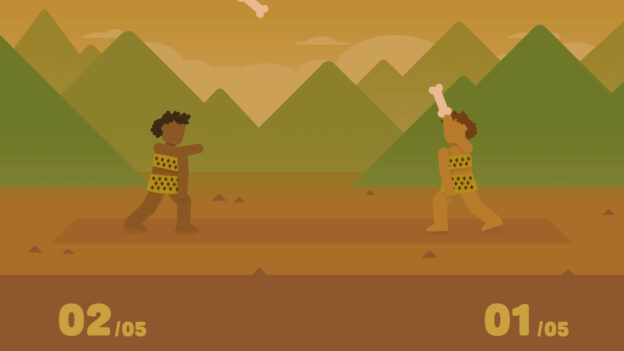Bomb Rush Cyberfunk Review – Review

Let’s get the elephant out of the room right away. Bomb Rush Cyberfunk is a new Jet Set Radio game. In the grand tradition of indie studios creating spiritual successors to dormant franchises, none have been so blatant in their lifting of source material. Everything about its gameplay and style is nearly identical to the SEGA classic, from the level progression, art direction, urban industrial locations, character proportions, and breakdancing animations, down to the eclectic soundtrack featuring tracks from composer Hideki Naganuma. Team Reptile has made it apparent the only thing keeping Bomb Rush from being Jet Set is pesky copyright law. And that’s not a slight; it’s high praise.
Jet Set Radio is the ultimate vibe game. The kind of game that stands out not with mechanics but through sheer force of artistic identity; capturing the rebellious optimism of hip-hop culture in the Y2K era with pioneering cel-shaded graphics, funky fresh beats, and memorable characters. It’s a style that is of its time and yet hasn’t aged a day. The same can’t be said for the controls. The Dreamcast original suffered the woes of many early 3D games of its time, with stiff unwieldy controls that betray the promise of being a nimble punk on skates hitting tricks, doing crime, and leaving the Five-0 in your dust. Jet Set Radio Future on XBOX improved the formula by modernizing the control scheme, but that didn’t mean it was polished. There was always a chasm in quality between the style and setting of Jet Set Radio and its minute-to-minute gameplay. Bomb Rush Cyberfunk finally closes that gap.
You play as Red and the rest of the Bomb Rush Crew rising up the ranks in New Amsterdam trying to earn enough rep to take on rival gangs across the five boroughs and become All City. Graffiti is how you earn rep, and painting pieces over those of your rivals is the way to get their attention. It’s up to you to find the spots to paint, and more importantly, learn how to reach them. At its core, Bomb Rush Cyberfunk is a 3D platformer on wheels. Whether it’s skateboards, BMX bikes, or in-line skates, you’re using these along with your boostpack to explore the semi-open world, discover secrets, and reach the places you’ll tag. Once you’ve earned enough rep, you can challenge your rivals in a head-to-head competition to earn the most points within 2 minutes.
Points are earned by building combos with tricks. These tricks can be performed at any time by pressing A, Y, or X, but you must be in the air, grinding a rail, or doing a manual to keep up the combo streak. Multipliers can be gained by taking hard corners on rails or by riding walls. But don’t think you can grind the same rails and ride the same walls; each one has to be new to count. Similarly, spamming the same trick will become stale, so your tricks need to be mixed up to net the most points.
It sounds technical on paper, but in practice, it’s absolutely electric. There is nothing quite like building speed, chaining a sequence of rail grinds, manuals, wall rides, jumps, mid-air dashes, and boosts to run up the number as high as you can take it, only to bail and eagerly do it all over again. It’s the mark of a great movement system when you catch yourself not progressing at all in the story or side objectives, but instead jamming out to the stellar soundtrack and hitting tricks for minutes on end for no other reason than the satisfaction of pulling off another killer combo. It’s the feeling I always hoped to experience with Jet Set Radio but never got to due to the everpresent jank. Team Reptile delivers what SEGA and Smilebit could not by honing a movement system that lowers the skill floor for newcomers by creating something that is polished and approachable while raising the skill ceiling with more nuances to master.
The level design complements the movement beautifully. These urban playgrounds contain collectibles in secret areas to reward exploration and at the end of obstacles to satiate those hungry for a challenge. Earning more rep than required to progress the story will unlock additional portions of the map with their own set of secrets and challenges, and it’s always a good idea to scour the maps after completing the story to do unique quest lines for unlocking characters. These zones are really dense, which is as much a blessing as it is a curse. You are provided a map via your flip phone and the pause screen, but it’s not all that helpful until after you have claimed the borough for your crew. Only then will you be able to go back and find the map data. This mechanic incentivizes paying attention to the thoughtful level design and making note of routes along the walls and rails of each zone. But when nothing is marked on your map and you can’t find your way through the twists and turns of zones like Pyramid Island or you happen to miss a gap to slide under, it can lead to frustration.
The police can be similarly irritating. Once you have thrown up enough pieces around town, the cops are alerted to your location, chasing you down with guns, turrets, snipers, and more. They’re easy to ignore at first, but once you are at max heat you will have an army on your tail, making forward progress miserable. It’s in these instances that you’ll want to locate an outhouse to lose the fuzz—and maybe change your fit while you’re at it. You can fight back by boosting and doing tricks into the police if you’d like, but this isn’t a real combat component of gameplay. If anything, it’s just an opportunity to break dance into your haters and humiliate them into the air with your sick art for extra points.
Team Reptile understands the vibe it’s going for and commits to it completely, and that goes beyond the joys of tagging lawmen just for kicks. Your flip phone isn’t just the way your crew communicates information; it’s also your map, your music, and your camera. You change characters and hail taxis not by selecting options on a screen but by busting moves in specific locations. It would be simpler to relegate these options to a menu but clear effort was put into making these details a cohesive part of the world even at the cost of player convenience. And I love Bomb Rush Cyberfunk all the more for it.
This brings us to the story, which oozes as much personality as everything else—even if the premise isn’t as fresh. Your journey as a cyberhead trying to get his flesh head back and understand his past is the amnesiac trope we’ve seen a million times but with extra steps. However, the execution is what kept me engaged with fun character interactions, striking cutscene direction, and unique gameplay integration. Throughout his journey of self-discovery, Red will be sucked into his subconscious. In this dream state, you as the player need to platform your way through an obstacle course built out of fragmented memories and surreal architecture. They don’t last long but these bite-sized sections are some of the most memorable. Bosses are less so, though. The few that you encounter are fine moments to punctuate the story but outside of a couple exceptions they don’t deliver the same awe or excitement.
We’ve already done a tech analysis and comparison across Switch, PC, and Steam Deck so I won’t reiterate the details. The cliff notes version is that Switch performance is adequate but not amazing. The game runs at stable resolutions and a consistent 30fps with an option to uncap the framerate if you wish. And you can expect pop-in issues and longer loading times. The couple of things I didn’t catch in my earlier testing were the handful of crashes I experienced late in the game. These were alarming at first but the generous auto-save threw me right back into the action without missing a beat. I’d also like to add that the pop-in during some later in-engine cutscenes was far more pronounced than in my initial tests. If you can get Bomb Rush elsewhere, then I’d recommend a version on better hardware but don’t feel like you are shortchanged by picking it up on Switch if you have to.
It’s easy to glance at Bomb Rush Cyberfunk and see a cheap imitation. A work whose value is found in what it takes rather than what it creates. But Team Reptile has proven that derivative art can surpass its inspirations. I can recall nearly half a dozen instances of me starting Jet Set Radio with the hope that it would finally click, that I could finally enjoy moving in that world as much as I enjoyed being in it, only to never make it past the second level. In a year chock full of landmark releases, I’m booting up Bomb Rush Cyberfunk again to make up for all the lost time, to play the game that I always hoped existed. Now that I have it, I simply just can’t get enough.




